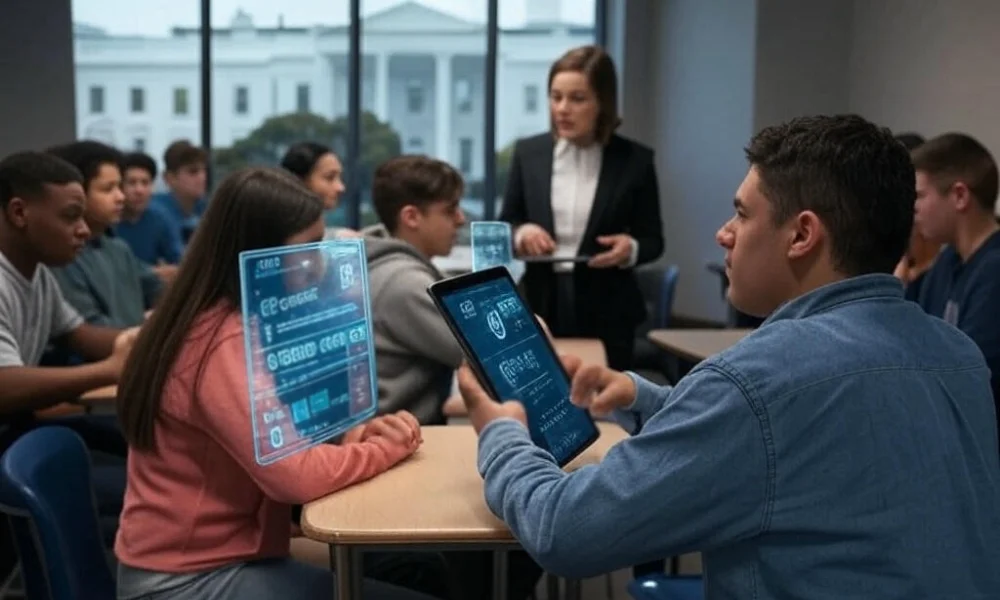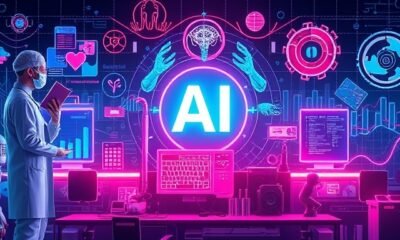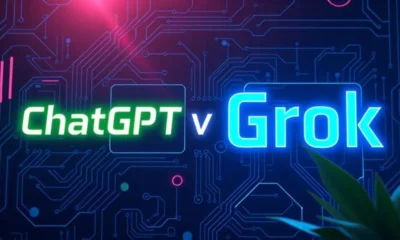Artificial Intelligence
Embracing AI Education for America’s Future
President Trump’s 2025 executive order on AI education is a game-changer for U.S. schools, aiming to equip students with the skills needed for AI-driven careers. This initiative ensures America stays competitive by prioritizing AI literacy in classrooms nationwide.

Artificial intelligence is rapidly reshaping our world, impacting everything from smart assistants to self-driving cars. President Trump’s executive order of April 23, 2025, takes a bold step in integrating AI training into U.S. schools, sparking excitement across the nation. This pivotal move aims to equip students with the skills necessary to thrive in an AI-driven economy, ensuring America’s competitiveness on the global stage.
Definition:
Artificial intelligence enables machines to mimic human thinking, solve problems, and automate tasks with efficiency. It drives innovations like personalized learning and revolutionizes industries, including medical diagnostics, offering significant benefits. AI is the backbone of tomorrow’s economy and society, transforming the way we live and work.
This blog explores the executive order’s objectives, the potential benefits, and the challenges it presents. By prioritizing AI literacy, it prepares American youth for high-demand careers, fostering economic growth and innovation. Let’s dive deeper into how this executive order reshapes education, shaping a better future for all.
Why Does AI Matter in Education?
AI is rapidly transforming industries, creating new career opportunities in data analysis and automation. As students face a tech-driven world, AI literacy becomes essential for future employability. Without early exposure to AI, American youth risk falling behind in the global race for technological dominance.
The executive order addresses this gap by making AI education a national priority. It empowers students to innovate, solve complex problems, and navigate the ethical challenges that come with AI technology. This strategic move ensures that America remains a global leader in technology for decades to come.
What’s the Current State of AI Education?
Most U.S. schools lack formal AI programs, offering only basic coding classes occasionally. According to a 2024 survey, just 10% of high schools teach AI-related courses regularly. Rural and underfunded schools face additional challenges, limiting access to essential tech education.
This disparity leaves many students unprepared for AI-driven careers, threatening America’s position in the global tech landscape. Nations like China have already integrated AI into their curricula, giving them a competitive edge. The executive order aims to close this divide, ensuring all students have access to AI education, regardless of their school’s funding.
What Does the Executive Order Include?
Signed on April 23, 2025, the executive order mandates AI training across U.S. K-12 schools. The initiative establishes a White House task force to coordinate efforts and secure funding for AI programs. Its main goal is to foster AI literacy and ensure students are prepared for the careers of the future.
Key actions in the order include teacher training, student certifications, and the launch of a Presidential AI Challenge. The Department of Education will prioritize AI in grants within 120 days. Public-private partnerships will provide resources to schools, ensuring AI programs are implemented effectively across the nation.
Why Is This Order a Game-Changer?
This executive order places AI education at the heart of America’s technological and economic strategy. It prepares students for high-paying AI jobs, addressing the growing shortage of skilled workers in the field. Early exposure to AI sparks curiosity and helps make technology more accessible to diverse learners nationwide.
Public support for the initiative has been strong, with platforms like X highlighting its importance for national security. As @AngelenoInsight recently posted, it is “critical for economic dominance.” This national push ensures that American youth will continue driving innovation, keeping the U.S. ahead in the global tech race.
How Will Students Benefit?
AI education equips students with the skills needed for careers in technology, significantly boosting employability. Personalized AI tools also enhance learning by adapting to individual student needs, improving educational outcomes. Students will gain essential critical thinking skills to address AI’s ethical challenges, such as bias and fairness.
- Career Readiness: Prepares students for roles like AI developers, data analysts, and engineers.
- Improved Learning: AI-powered tools personalize lessons, helping students excel in their studies.
- Ethical Awareness: Teaches students how to navigate the societal impacts of AI responsibly.
What Advantages Do Teachers Gain?
Teachers will receive specialized AI training to integrate technology into subjects like math and science. AI tools will streamline grading and lesson planning, saving time for more meaningful student engagement. Professional development through AI training empowers educators to inspire and shape the next generation of innovators.
- Efficiency: AI will automate administrative tasks, freeing up teachers for creative, student-focused instruction.
- Skill Growth: Teacher training builds confidence in using AI tools effectively in classrooms.
This support will transform classrooms across the nation, making AI a natural part of daily education.
How Does Society Win?
An AI-literate workforce will drive technological innovation, bolstering America’s economy and global influence. Informed citizens will also be better equipped to handle AI’s ethical challenges, such as privacy concerns and fairness issues. This initiative strengthens communities by ensuring opportunities are accessible to all socioeconomic groups.
- Economic Growth: A skilled workforce will fuel the growth of tech industries, attracting investments.
- Ethical Progress: Educated youth will advocate for responsible AI use, ensuring a fairer, more ethical future.
This national initiative sets the stage for a generation prepared to lead in the tech-driven future.
What Challenges Could Slow Progress?
Limited budgets in underfunded schools pose significant barriers to implementing AI programs effectively. There is also a shortage of qualified AI instructors, which risks uneven program deployment across districts. Privacy concerns surrounding student data need to be addressed with strong safeguards to maintain trust.
- Resource Gaps: Rural schools often lack the necessary infrastructure, such as computers and reliable internet.
- Teacher Shortages: Few educators are trained to teach AI-related subjects effectively.
These challenges demand creative solutions to ensure all students, regardless of background, can access AI education.
How Does the U.S. Compare Globally?
China’s aggressive 2025 AI education policy aims to establish 500 AI-focused schools by 2030. Singapore has already integrated AI education in primary schools, fostering early tech fluency. The U.S. approach, relying on public-private partnerships, is distinct from state-driven models seen in other countries.
- China’s Scale: China’s massive investment in AI education outpaces the U.S. in both scope and speed.
- Finland’s Model: Finland’s free AI courses for citizens promote inclusivity and accessibility.
America must act swiftly to ensure it maintains its leadership in global AI development.
What’s Next for AI Education?
Pilot programs will soon launch in tech hubs like California, setting the stage for nationwide implementation. The Presidential AI Challenge will encourage student projects and spark greater interest in AI education across the U.S. Long-term, AI could become as fundamental as subjects like math in school curricula.
- Short-Term Wins: AI certifications and apprenticeships will help prepare students for tech-related jobs.
- Future Vision: This initiative fosters a lifelong culture of learning, shaping an innovative, tech-savvy America.
Conclusion:
The executive order on AI education marks a pivotal moment in U.S. history. It ensures that American students are equipped with the skills necessary to succeed in a rapidly evolving, AI-driven world. By prioritizing AI literacy, the U.S. will remain a global leader in technology and innovation for years to come.
Are you excited about how AI is shaping the future of education? How do you think AI literacy will impact your career or community? Share your thoughts and insights in the comments below!
-

 Artificial Intelligence4 months ago
Artificial Intelligence4 months agoWhat is Artificial Intelligence? A Comprehensive Guide for Businesses and Enthusiasts
-

 Artificial Intelligence2 months ago
Artificial Intelligence2 months agoHow to Use Grok AI: A Complete Guide
-

 Artificial Intelligence4 months ago
Artificial Intelligence4 months agoWhat is DeepSeek? Revolutionizing AI with Cutting-Edge Solutions
-

 Artificial Intelligence4 months ago
Artificial Intelligence4 months agoUnlocking the Power of Artificial Intelligence Tools
-

 Artificial Intelligence4 months ago
Artificial Intelligence4 months agoWhat is Quantum Artificial Intelligence? How It Works and Why It Matters
-

 Artificial Intelligence3 months ago
Artificial Intelligence3 months agoChallenges and Ethical Considerations Of Using Al In Predictive Policing
-

 Artificial Intelligence2 months ago
Artificial Intelligence2 months agoWhat is Grok AI? A Game-Changing Chatbot with Real-Time Insights
-

 Artificial Intelligence2 months ago
Artificial Intelligence2 months agoGrok vs. ChatGPT: Which AI Chatbot is Right for Use?



